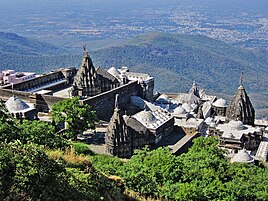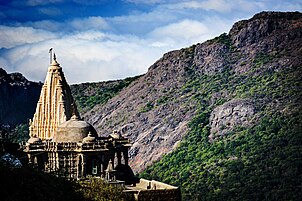Girnar
| Girnar Mount | |
|---|---|
| ગિરનાર પર્વત Revatak Parvata | |
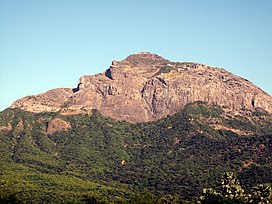 Mount Girnar | |
| Highest point | |
| Elevation | 1,145[1] m (3,757 ft) |
| Prominence | 1,130 m (3,710 ft) |
| Listing | List of Indian states and territories by highest point, Ribu |
| Coordinates | 21°29′41″N 70°30′20″E / 21.49472°N 70.50556°E |
| Geography | |
| Geology | |
| Mountain type | Igneous |
Girnar is an ancient hill in Junagadh, Gujarat, India. It is one of the holiest pilgrimages for Hindu Jains, where the 22nd Tirthaṅkar, Lord Neminath attained omniscience, and later nirvana along with other five hundred and thirty three enlightened sages. This is well described in ancient texts such as Kalpa Sūtra written by acharya Bhadrabāhu.[2]
Geology
[edit]Mount Girnar is a major igneous plutonic complex which intruded into the basalts towards the close of the Deccan Trap period. The rock types identified in this complex are gabbros (tholeiitic and alkalic), diorites, lamprophyres, alkali-syenites and rhyolites. The parent gabbroic magma is shown to have given rise in sequence to diorites, lamprophyres and alkali-syenites. The rhyolite, though earlier considered a product of differentiation, is now believed to be an independent magma without any genetic link with the gabbro and its variants.[3][4]
History
[edit]
Ashoka edicts
[edit]Fourteen of Ashoka's Major Rock Edicts, dating to circa 250 BCE, are inscribed on a large boulder that is housed in a small building located outside the town of Junagadh on Saurashtra peninsula in the state of Gujarat, India. It is located on Girnar Taleti road, at about 2 km (1.2 mi) far from Uperkot Fort easterly, some 2 km before Girnar Taleti. An uneven rock, with a circumference of seven meters and a height of ten meters, bears inscriptions etched with an iron pen in Brahmi script in a language similar to Pali and date back to 250 BCE, thus marking the beginning of written history of Junagadh.[5]
On the same rock there are inscriptions in Sanskrit added around 150 CE by Mahakshatrap Rudradaman I, the Saka (Scythian) ruler of Malwa, a member of the Western Satraps dynasty (see Junagadh rock inscription of Rudradaman).[5] The edict also narrates the story of Sudarshan Lake which was built or renovated by Rudradaman I, and the heavy rain and storm due to which it had broken.[6]
Another inscription dates from about 450 CE and refers to Skandagupta, one the last Gupta emperors.[6]
The protective building around the edicts was built in 1900 by Nawab Rasool Khan of Junagadh State at a cost of Rs 8,662. It was repaired and restored in 1939 and 1941 by the rulers of Junagadh. The wall of the structure had collapsed in 2014.[7]
A much smaller replica of these Girnar edicts has been positioned outside the entrance of the National Museum in Delhi.[8]
Similarly, inside the Parliament Museum at New Delhi, an exhibit replicates the act of artists sculpting inscriptions of Girnar edict on a rock.[9]
-
Ashoka's Rock Edict
-
Housing for Ashoka's edicts.
-
Estampage of a part of the inscriptions.
-
"Aṃtiyako Yona Rājā" (𑀅𑀁𑀢𑀺𑀬𑀓𑁄𑀬𑁄𑀦𑀭𑀸𑀚𑀸, "The Greek king Antiochos"), mentioned in Major Rock Edict No.2, at Girnar.[10]
A little further from Ashoka's inscription, on the right side of the road, there is a large stone standing which looks like exact replica of Ashoka's inscription.
Jain sources
[edit]Jain texts record Girnar mountain as an ancient pilgrimage site from where crores (koda-kodi) of monks have attained liberation. Neminath, the 22nd Tirthankara attained Moksha from this hill. Śvetāmbara tradition also considers Girnar to be an eternally Jain pilgrimage. 3rd century BCE text Kalpa Sūtra by Acharya Bhadrabāhusuri mentions Girnar hill to be the place of initiation, Kevala jnana, and Moksha of the 22nd Tirthankara Neminatha.[2][11]
Sixth century BCE Jain text Uttaradhyayana Sutra which is believed to be the direct words of Mahavira, mentions that Neminatha ascended Mount Raivataka to become an ascetic in the 22nd chapter.[12]
Girnar Ropeway
[edit]
Girnar ropeway is Asia's longest ropeway. First proposed in 1983, the construction started only in September 2018 due to government approval delays and litigation. The construction and operation is managed by Usha Breco Limited. The project was inaugurated on 24 October 2020 by now Prime Minister Narendra Modi.[13] The ropeway is 2,320 metres (7,610 feet) long and takes passengers 850 metres (2,790 feet) above the hill to the Ambika Jain temple (Ambaji) within 10 minutes.[14]
Jain Temples
[edit]Girnar Jain temples are a group of Śvetāmbara Jain temples and one Digambara temple atop Mount Girnar. Neminatha, the 22nd Tirthankara had renounced the world and become an ascetic, and then attained omniscience and liberation, all atop this mountain. Therefore, the hill is sacred to both the sects of Jainism.[15][16]
It is home to sixteen exquisitely sculpted temples. The first peak, or Tunk, consists of the black granite temple dedicated to Lord Neminath, constructed in 1128 AD. The temple features intricate carvings on its pillars and is adorned with unique colored mosaics. The second Tunk houses the demi-goddess Ambika temple, while the third and fourth Tunks are significant for containing the foot-idols of Muni Shambh Kumar and Pradhyuman Kumar, who visited here. The fifth Tunk, requiring a climb of 10,000 steps from the base, enshrines the foot-idol of Bhagwan Neminath. Additionally, other sacred sites include the cave of Rajul, the Rathanemi temple (dedicated to Neminath’s younger brother), and Sahasavan.[17]
Girnar holds great significance in Jain history and legends. As per Jain scriptures, it is believed that Girnar has been in existence since eternity and that the 22nd Tirthankara Neminatha visited and performed his penance on this mountain in the present Avsarpini. Canonical Śvetāmbara scriptures such as Kalpa Sūtra,[15] Āvassaya-sutta, Nāyā-dhamma-kahāo, Uttarajjhayaṇa-sutta[16] and non-canonical ancient works of literature such as Prabhavak Charitra[18] by Acharya Prabhachandrasuri, Neminah Chariu, and Samyaktva Saptatika by Acharya Haribhadrasuri, Trīṣaṣṭiśalākāpuruṣacharitra[19] by Acharya Hemachandrasuri, Vastupala-Mahakavya by Acharya Udayprabhasuri, Kumarpalabhupal-Charitra[20] by Acharya Jaisinhsuri, Jain Meghdoot by Acharya Merutungasuri, Raivatgirirasu by Acharya Vijaysensuri are some prominent scriptures emphasizing the importance of Girnar in Jainism.[21][22][23]
Karnavihāra Prāsāda, one of the main temples atop the hill, is dedicated to Neminatha. Its main idol is made of black granite and the temple itself features Maru-Gurjara architecture. Vividha Tirtha Kalpa by Acharya Jinprabhasuri mentions that the original idol was made of clay and that the temple was made of wood. Ratnasār came to Girnar with a sangha and performed ritualistic bathing of the clay idol due to which it dissolved in the holy water. Due to this, Ratnasār got upset and fasted for 21 days, after which, demigoddess Ambika, pleased by his devotion, gave him an idol of Neminatha. Therefore the current idol of Neminatha was installed by a Śrāvaka named Ratnasār, from Kashmir, in the 10th century CE. He is said to have had obtained this idol from demigoddess Ambika.[24][25][26] It was later renovated by Sajjana, a minister of Jaysimha Siddharaja in the 12th century CE. Sajjana utilized three years' worth of tax revenue collected from the people of Saurashtra. When Jaysimha Siddharaja got to know about the incident, he decided to investigate it. However, until then, Sajjana had already raised funds from the Śrāvakas and presented them to Siddharaja. Sajjana told Siddharaja that the temple was named Karnavihāra Prāsāda after Siddharaja’s father Karnadev. Pleased with the gesture, Siddharaja approved the revenue funds spent on the renovation of the temple.[27][28]
Apart from Karnavihāra Prāsāda, there are other temples dedicated to other Tirthankaras built across centuries such as: Adbad Adinath Temple, Panchmeru Temple, Merak Vasahi Temple,[29] Sangram Soni’s Temple, Kumarpala’s Temple, Vastupala—Tejpala Temple,[30] Mansingh Bhojraj Temple,[31] Samprati Maharaja Temple, Amizara Parshwanath Temple, Rajimati's Cave, and Sahasavan Temple.[32][33]
Shatrunjay Mahatmya, a text written by Acharya Dhaneshwarsuri, a monk of the Śvetāmbara sect of Jainism mentions that Sahasavan’s original name was Sahatramra-van (transl. a forest with thousands of mango trees).[34] It is the place where Neminatha renounced the world and became an ascetic along with 1000 other kings on the 6th day of bright half of Shravan month.[35] After 54 days of becoming an ascetic, Neminatha came back to Sahasavan, where he attained omniscience on the 15th day of dark half of Bhadrapad month.[36] To commemorate the auspiciousness of both the events, Jains installed footprints of Neminatha at both these places.[37][38]
Neminatha spent many years in spreading wisdom after attaining omniscience and then he attained Moksha on the fifth peak of Mount Girnar on the 8th day of bright half of Ashadha month.[39][40] Footprints of Neminatha were placed at the spot where he attained moksha to commemorate the occasion. The temple that now houses an idol of Dattatreya, in renowned archaeologist James Burgess's works, is said to have had Lord Neminath's sacred footprints and that it was administered by a naked ascetic (Digambara monk), implying that it was originally a Jain temple.[41] However, currently, the place of Neminatha’s nirvana is disputed between Jains and followers of Dattatreya who believe that it is also the place of Dattatreya’s penance. An idol of Dattatreya was placed and a new shrine was built surrounding the footprints of Neminatha. Some cases between Jains and Hindus, seeking a reconstruction of canopies above the footprints of Neminatha and a removal of the idol of Dattatreya that was illegally established in 2004 and other illegal constructions are pending in the Gujarat High Court.[42]
-
Jain Temple on Girnar mountain
-
Arisht Neminath temple
-
Ancient Idol of Amizara Parshwanath in a Cave Temple at Girnar Hill
-
Vastupala Vihara
-
Samprati Raja temple
-
Chaumukhji Temple
-
Dharamchand Hemchand temple
Ambika Temple
[edit]
This temple is dedicated to Jain deity Ambika yakshi (Ambaji), an attendant of Lord Neminath. The early temple was built before 784 CE (probably in middle of the 8th century) because Digambar Jain Acharya Jinasen's Harivamsapurana (Saka Samvat 705, 783 CE) mentions the temple.[43] An inscription dated Vikram Samvat 1249 (1192 CE) mentions Vaghela minister Vastupala's pilgrimage to Ambika temple on Raivataka (Girnar) hill. Narendraprabhsuri mentions that Vastupala had installed idols of himself and his brother Tejapala in the temple. Jinharshasuri mentions that Vastupala and his brother Tejapala visited as well as built the large mandapa of the temple and parikara of Ambika.[44][45] A praśasti eulogy given at the end in a golden lettered copy of Kalpasutra dated Vikram Samvat 1524 (1468 CE) mentions that a Jain Shreshthi (merchant) named Samal Sah restored and renovated the Ambika temple on Girnar.[44][46][45] As mentioned in Jain pilgrimage travelogues, the temple had Ambika as a Jain yakshika deity. The Girnar patta from Samvat 1507 in Ranakpur Jain temple also depicts Ambika in the similar manner. The temple is built according to the Jain tradition and the mandapa ceiling match with the Girnar Jain temples.[45]
The present temple is built around the 15th century. The temple was historically a Jain temple.[47] So the temple construction, renovation and reconstruction history extends from the mid-8th century to the 15th century.[44]
As per archaeologist James Burgess's works on Gujarat's history, Ambika temple was not a Hindu shrine and that Jains had built it and Hindus had occupied it later.[48]
Hindu Temples
[edit]This section needs expansion. You can help by adding to it. (October 2024) |
Atop Girnar's highest peak, reached by a 10,000-step climb, is a temple managed by devotees of Dattatreya.[49] This temple, in renowned archaeologist James Burgess's works, is said to have had Lord Neminath's sacred footprints and that it was administered by a naked ascetic, implying that it was originally a Jain temple.[50] The Jain community has contested the ownership and worship rights of this temple in the Gujarat High Court, and the matter remains under judicial consideration.[51] On the trek from Ambika temple to the disputed site, there's a Gorakhnath temple located on the intermediate peak.[52]
Further up there's a lower peak which is not easily accessible where a shrine of goddess Mahakali is located which is also known as Mahakali Khappar by locals.[53] On the second trail to descent the mountain, there are two temples called Bharat-van and Sita-van which are located in the forests named after Sita and Bharata.[54]
-
Gorakhnath Temple of Girnar
-
Dattatreya (Neminath) Temple of Girnar
Girnar's Initial trek
[edit]The base of the mountain, known as Girnar Taleti, is about 4 km east of the center of Junagadh. There are temples and other sacred places all along this stretch.[55]
The traveller, in order to reach Girnar Taleti from Junagadh city, will pass through the Wagheshwari or Vagheshwari Gate (Girnar Darwaza), which is close to the Uparkot fort area, Easterly.
At about 200 metres from the gate, to the right of the road, is the Temple of Wagheshwari (Upale Vagheshwari maa), which is joined to the road by a causeway about 150 yards long. An ancient Verai Mata mandir and a modern Gayatri Shakti Peeth mandir are nearby.
About a furlong beyond this is a stone bridge, and just beyond it on the right are the Ashoka's Major Rock Edicts.[56] The edicts are inscribed high up on a large, domed mass of black granite measuring roughly 20 feet x 30 feet. The inscription is in Brahmi script.[5]
On leaving Ashoka's edicts, the route crosses the handsome bridge over the Sona-rekha, which here forms a fine sheet of water over golden sand, then passes a number of temples, at first on the left bank of the river and then on the right, to the largest of the temples. This is dedicated to Damodar, a name of Krishna, from Dam, a rope, because by tradition his mother in vain attempted to confine him with a rope when a child. The reservoir, Damodar Kund, at this place is accounted very sacred.[56]
Next is an old shrine of Bhavnath, a form of Shiva, close to Girnar Taleti; Mrigi kund and Sudharshan lake are nearby.
Most persons who are not active climbers will probably proceed up the mountain in a swing doli from Taleti. A long ridge runs up from the west, and culminates in a rugged scarped rock, on the top of which are the temples. Close to the old shrine is a well called the Chadani vav.[56]
The paved way begins just beyond this and continues for two-thirds of the ascent. The first resthouse, Chadia Parab, is reached, 480 feet, above the plain; and the second halting-place at Dholi-deri, 1000 feet above the plain. From here the ascent becomes more difficult, winding under the face of the precipice to the third resthouse, 1400 feet up. The path turns to the right along the edge of a precipice, which is very narrow, so that the doli almost grazes the scarp, which rises perpendicularly 200 feet above the traveller. On the right is seen the lofty mountain of Datar, covered with low jungle. At about 1500 feet there is a stone dharmsala, and from this there is a fine view of the rock called the Bhairav-Thampa, "the terrific leap," because devotees used to cast themselves from its top, falling 1000 feet or more.[56]
At 2370 feet above Junagadh, the gate of the enclosure known as the Deva Kota, or Ra Khengar's Palace, is reached.[56]
Festivals
[edit]Jain festivals like Mahavir Jayanti, Paryushana, and birth and nirvana kalyanaks of Lord Neminath are celebrated by Jains.[57]
The main event for Hindus is the Maha Shivaratri fair held every year on the 14th day of the Hindu calendar month of Magha. At least 1 million pilgrims visit the fair to participate in pooja and parikrama of Girnar hill. The procession begins at Bhavnath Mahadev Temple at Bhavnath. It then proceeds onwards to various akharas of various sects of sadhus, which are in Girnar hill from ancient times. The procession of sadhus and pilgrims ends again at Bhavnath temple after visiting Madhi, Malavela and Bor Devi temple. The fair begins with hoisting of fifty-two Gaja long flags at Bhavnath Mahadev temple. This fair is the backbone of the economy of Junagadh, as more than ten lakh pilgrims who visit the fair generate a revenue of 250 million in only five days.[58][59][60]
Tanks
[edit]Outside to the north of the Kumarapala's temple, there is the Bhima Kunda, a tank measuring 70 feet by 50 feet. Below it and on the verge of the cliff is a smaller tank of water and near it a small canopy supported by three roughly hewn pillars and a piece of rock containing a short octagonal stone called Hathi pagla or Gajapada, the elephant foot, a stratum on the top of which is of light granite and the rest of dark the lower part is immersed in water most of the year.[61]
As per historical records, Sajjana, the minister of Chaulukya king Siddharaja Jayasimha, built the Neminatha temple using the state treasury. When he collected the funds to return as a compensation, the king declined to accept it so the funds were used to build the temple.[62]
Sahastraphana (thousand hooded) Parshwanatha, the image which was consecrated in 1803 CE (VS 1459) by Vijayajinendra Suri, is currently the central deity in the temple. The temple originally housed the golden image of Mahavira and brass images of Shantinatha and Parshwanatha on its sides.[63]
The east facing temple has 52 small shrines surrounding the central temple. It has an open portico with ceilings with fine carvings. In the bhamti or cloisters surrounding the court, there are also some remarkable designs in carved ceilings. The roof of the rangamandapa has fine carvings. The shrine proper must have been removed and replaced with new one at the end of the sixteenth century or the start of the seventeenth century. It is known that Karmachandra Bachchhavat, minister of the king of Bikaner, had sent a funds to renovate temple in Shatrunjaya and Girnar under Jinachandrasuri IV of Kharatara Gaccha during the reign of Akbar. There is a shrine housing replica of Ashtapada hill in the south, shrine with Shatrunjayavatar in west, behind the main temple, and Samet Shikhar (or Nandishwar Dwipa) in north.[64][65]
See also
[edit]References
[edit]- ^ https://www.peakbagger.com/peak.aspx?pid=53262
- ^ a b "Jaina Sutras, Part I (SBE22): Lives of the Ginas: Life of Arishtanemi". sacred-texts.com. Retrieved 22 September 2024.
- ^ R. N. Sukheswala (January 1982). "Igneous Complex of Mount Girnar, Saurashtra, Gujarat - A Reappraisal". Journal of the Geological Society of India. 23 (1): 13–18. doi:10.17491/jgsi/1982/230102.
- ^ Mihir K. Bose (January 1973). "Petrology and geochemistry of the igneous complex of Mount Girnar, Gujarat, India". Contributions to Mineralogy and Petrology. 39 (3): 247–266. Bibcode:1973CoMP...39..247B. doi:10.1007/BF00383107. ISSN 0010-7999. S2CID 129626191.
- ^ a b c Keay, John (2000). India, a History. New York, United States: Harper Collins Publishers. pp. 129–131. ISBN 978-0-00-638784-8.
- ^ a b "Structure Covering Ashoka's Edicts Collapses in Gujarat". Outlook India. Retrieved 23 July 2020.
- ^ "Roof over Ashoka rock edicts in Junagadh crashes". The Times of India. 19 July 2014. Retrieved 21 March 2016.
- ^ "Heritage building caves in but Ashoka's edicts as steady as rock". The Pioneer. Retrieved 23 July 2020.
- ^ "Parliament Museum, New Delhi, India - Official website - Rock Edicts". parliamentmuseum.org. Retrieved 23 July 2020.
- ^ Inscriptions of Asoka. New Edition by E. Hultzsch (in Sanskrit). 1925. p. 3.
- ^ admin (18 May 2020). "The religious importance of Girnar for Jains". The Thumping Nomad. Retrieved 16 October 2024.
- ^ "Jaina Sutras, Part II (SBE45): Uttarâdhyayana: Twenty-Second Lecture. Rathanêmi". sacred-texts.com. Retrieved 16 October 2024.
- ^ "PM Narendra Modi inaugurates Girnar ropeway in Gujarat". @businessline. 24 October 2020. Retrieved 25 April 2021.
- ^ "Search, Seek, and Discover Jain Literature".
- ^ a b "Jaina Sutras, Part I (SBE22): Lives of the Ginas: Life of Arishtanemi". sacred-texts.com. Retrieved 15 December 2024.
- ^ a b "Jaina Sutras, Part II (SBE45): Uttarâdhyayana: Twenty-Second Lecture. Rathanêmi". sacred-texts.com. Retrieved 15 December 2024.
- ^ "Search, Seek, and Discover Jain Literature".
- ^ Prabhachandrasuri, Acharya. "Prabhaavaka Charitra".
- ^ www.wisdomlib.org (9 March 2018). "Part 4: Founding of Nemi's congregation". www.wisdomlib.org. Retrieved 15 December 2024.
- ^ Jaisinhasuri, Acharya. "Kumarapalabhupala-charitra".
- ^ Hemvallabhsuri, Acharya. "Girnar Granthoni Godma".
- ^ Hemvallabhsuri, Acharya. "Girnar Granthoni Godma".
- ^ Hemvallabhsuri, Acharya. "Girnar Granthoni Godma".
- ^ Jinaprabhasuri, Acharya. "Vividha Tirtha Kalpa".
- ^ Desai, Mohanlal. "Girnar Tirthoddhar Raas".
- ^ Hemvallabhsuri, Acharya. "Girnar Granthoni Godma Volume 2".
- ^ Desai, Mohanlal. "Girnar Tirthoddhar Raas".
- ^ Pedhi, Anandji Kalyanji. "Mahatirth Ujjayantgiri Girnar".
- ^ Pedhi, Anandji Kalyanji. "Mahatirth Ujjayantgiri Girnar".
- ^ Pedhi, Anandji Kalyanji. "Mahatirth Ujjayantgiri Girnar".
- ^ Pedhi, Anandji Kalyanji. "Mahatirth Ujjayantgiri Girnar".
- ^ Desai, Mohanlal. "Girnar Junagadh Guide".
- ^ Pedhi, Anandji Kalyanji. "Mahatirth Ujjayantgiri Girnar".
- ^ Dhaneshwarasuri, Acharya. "Shatrunjaya Mahatmya".
- ^ Vachanmala, Jain Sasti. "Girnar Tirthno Itihaas".
- ^ Pedhi, Anandji Kalyanji. "Mahatirth Ujjayantgiri Girnar".
- ^ Parshottamdas, Daulatchand. "Girnar Mahatmya".
- ^ Desai, Mohanlal Meghji. "Girnar Junagadh Guide".
- ^ Dhaneshwarasuri, Acharya. "Shatrunjaya Mahatmya".
- ^ Vachanmala, Jain Sasti. "Girnar Tirthno Itihas".
- ^ Burgess, James. "Report on the Antiquities of Kathiawad and Kachh, 1874-75". p. 175.
- ^ Patel, Justice Jayant. "Bandilalji Digamber Jain Karkhana vs State Of Gujarat on 17 February, 2005".
- ^ www.wisdomlib.org (9 March 2018). "Part 4: Founding of Nemi's congregation". www.wisdomlib.org. Retrieved 8 December 2024.
- ^ a b c "Jaina Sutras, Part II (SBE45): Uttarâdhyayana: Twenty-Second Lecture. Rathanêmi". sacred-texts.com. Retrieved 8 December 2024.
- ^ a b c Dhaky, M. A. (1997). Shah, Jitendra B. (ed.). મહાતીર્થ ઉજ્જયતગિરિ (ગિરનાર તીર્થ) [Mahatirtha UjjayantGiri (Girnar Tirtha)]. Ahmedabad: Sheth Anandji Kalyanji. pp. 5, 42–43.
- ^ Sompura, Kantilal F. (1968). The Structural Temples of Gujarat, Upto 1600 A.D. Gujarat University. p. 215. ISBN 978-0-86186-245-0.
- ^ Tiwari, Maruti Nandan Prasad (1989). Ambikā: In Jaina Art and Literature. Bharatiya Jnanpith.
- ^ Burgess, James. "Report on the Antiquities of Kathiawad and Kachh, 1874-75". p. 175.
- ^ Kulkarni, Gourav (2021). Girnar Dattatreya Shikhar Where Science Merges with the Supreme Divinity!. Chennai, India: Notion Press. pp. 5–56. ISBN 978-1-68-563895-5.
- ^ Burgess, James. "Report on the Antiquities of Kathiawad and Kachh, 1874-75". p. 175.
- ^ "Jains seek right to worship at Girnar's 5th peak, move Gujarat HC". The Times of India. 18 February 2024.
- ^ Dave, Jayantakr̥ṣṇa (1991). Immortal India Vol. 2. India: Bharatiya Viyda Bhavan. pp. 115–121.
- ^ Chatterjee, Ramananda (1943). The Modern Review Vol 73-74. Calcutta, India: Modern Review Office. p. 40.
- ^ Chatterjee, Ramananda (1943). The Modern Review Vol 73-74. Calcutta, India: Modern Review Office. p. 40.
- ^ "Mt. Girnar, Pilgrimage Centre, Junagadh, Tourism Hubs, Gujarat, India". gujarattourism.com. Archived from the original on 23 July 2020. Retrieved 23 July 2020.
- ^ a b c d e Murray, John (1911). "A handbook for travellers in India, Burma, and Ceylon". Internet Archive. pp. 155–157. Retrieved 28 January 2016.
- ^ "Girnar | District Junagadh, Government of Gujarat | India". Retrieved 16 October 2024.
- ^ "બાવન ગજની ધ્વજાનાં આરોહણ સાથે આજથી મહાશિવરાત્રિ મેળો Shivaratri fair begins today with hoisting of 52 gaja dwaja". Sandesh. 16 February 2012. Retrieved 22 August 2012.[permanent dead link]
- ^ "ગિરનાર ઃ લીલી પરિક્રમા ઃ પરકમ્મા Girnar - Lili Parikrama". Gujarat Samachar. 4 August 2012. Archived from the original on 10 October 2012. Retrieved 22 August 2012.
- ^ "જૂનાગઢની આર્થિક કરોડરજજુ શિવરાત્રિનો મેળો : પાંચ દિવસમાં રૂ.રપ કરોડનો લાભ Junagadh's economic backbone - Girnar Shivaratri fair - generates income of 25 crores in five days". Sandesh. 18 February 2012. Archived from the original on 23 December 2007. Retrieved 22 August 2012.
- ^ Burgess 1876, p. 169.
- ^ Dhaky 2010, p. 134.
- ^ Dhaky 2010, pp. 134–135.
- ^ Burgess 1876, p. 168.
- ^ Dhaky 2010, p. 135-137.
Works cited
[edit]- Burgess, James (1876). Report on the Antiquities of Kâṭhiâwâḍ and Kachh, Being the Result of the Second Season's Operations of the Archaeological Survey of Western India, 1874-75. London: India Museum.
 This article incorporates text from this source, which is in the public domain.
This article incorporates text from this source, which is in the public domain. - Dhaky, M. A. (2010). Shah, Jitendra B. (ed.). સાહિત્ય, શિલ્પ અને સ્થાપત્યમાં ગિરનાર [Girnar in Literature, Sculptures and Architecture]. L. D. Series: 148 (Sambodhi-Puratatva-Visheshank-2) (in Gujarati). Ahmedabad: Lalbhai Dalpatbhai Institute of Indology. ISBN 978-81-85857-30-5.



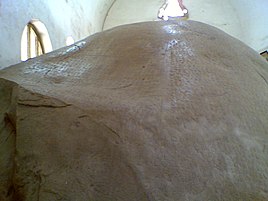

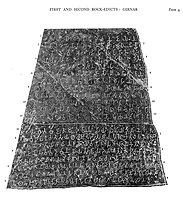
!["Aṃtiyako Yona Rājā" (𑀅𑀁𑀢𑀺𑀬𑀓𑁄𑀬𑁄𑀦𑀭𑀸𑀚𑀸, "The Greek king Antiochos"), mentioned in Major Rock Edict No.2, at Girnar.[10]](http://upload.wikimedia.org/wikipedia/commons/thumb/2/2c/Amtiyako_Yona_Raja_in_Major_Rock_Edicts_No2_in_Girnar.jpg/465px-Amtiyako_Yona_Raja_in_Major_Rock_Edicts_No2_in_Girnar.jpg)
